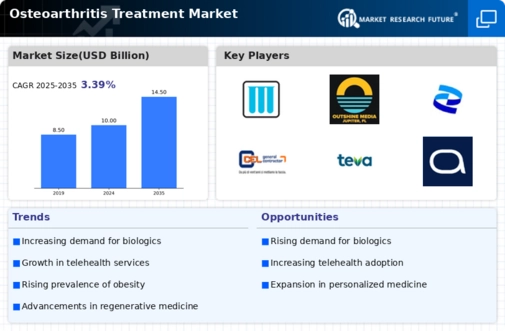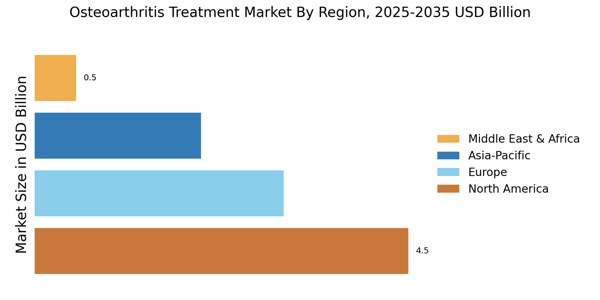Rising Healthcare Expenditure
The Osteoarthritis Treatment Market is benefiting from rising healthcare expenditure across various regions, which facilitates access to advanced treatment options. Increased investment in healthcare infrastructure and services is enabling patients to seek timely interventions for osteoarthritis. According to recent data, healthcare spending is projected to grow at a compound annual growth rate (CAGR) of 5.4% over the next several years. This trend is likely to enhance the availability of osteoarthritis treatments, including pharmaceuticals, physical therapy, and surgical options. As patients become more aware of their treatment choices and the importance of early intervention, the demand for effective osteoarthritis therapies is expected to rise, further propelling the Osteoarthritis Treatment Market.
Growing Awareness and Education
The Osteoarthritis Treatment Market is also being propelled by growing awareness and education regarding osteoarthritis and its management. Public health campaigns and educational initiatives are increasingly informing patients about the importance of early diagnosis and treatment options available. This heightened awareness is likely to lead to earlier consultations with healthcare professionals, resulting in increased demand for osteoarthritis treatments. Moreover, healthcare providers are emphasizing the significance of lifestyle modifications and non-pharmacological interventions, which are becoming integral components of osteoarthritis management. As patients become more informed about their condition, the Osteoarthritis Treatment Market is expected to witness a surge in demand for both traditional and innovative treatment modalities.
Advancements in Treatment Modalities
The Osteoarthritis Treatment Market is significantly influenced by advancements in treatment modalities, including the development of novel pharmacological agents and minimally invasive surgical techniques. Recent innovations in biologics and disease-modifying osteoarthritis drugs (DMOADs) are reshaping the treatment landscape, offering patients more effective options. For instance, the introduction of intra-articular injections, such as hyaluronic acid and corticosteroids, has shown promise in alleviating symptoms and improving joint function. Additionally, the rise of regenerative medicine, including stem cell therapy, is garnering attention as a potential game-changer in the Osteoarthritis Treatment Market. These advancements not only enhance patient outcomes but also stimulate market growth as healthcare providers seek to adopt the latest technologies and therapies.
Aging Population and Increased Prevalence
The Osteoarthritis Treatment Market is experiencing a notable surge due to the aging population, which is increasingly susceptible to osteoarthritis. As individuals age, the likelihood of developing joint-related issues escalates, leading to a higher demand for effective treatment options. Current estimates suggest that approximately 27 million adults in the United States alone are affected by osteoarthritis, a figure that is expected to rise as the population ages. This demographic shift is prompting healthcare providers and pharmaceutical companies to focus on innovative treatment solutions, thereby driving growth in the Osteoarthritis Treatment Market. Furthermore, the increasing prevalence of obesity, which exacerbates joint stress, is likely to compound the issue, further amplifying the need for targeted therapies and interventions.
Technological Integration in Treatment Approaches
The Osteoarthritis Treatment Market is witnessing a transformation due to the integration of technology in treatment approaches. Digital health solutions, including telemedicine and mobile health applications, are enhancing patient engagement and adherence to treatment regimens. These technologies facilitate remote monitoring and provide patients with access to healthcare professionals, thereby improving overall management of osteoarthritis. Furthermore, the use of artificial intelligence and machine learning in developing personalized treatment plans is gaining traction. This technological integration not only streamlines the treatment process but also empowers patients to take an active role in their healthcare. As technology continues to evolve, the Osteoarthritis Treatment Market is likely to experience significant growth driven by these innovative approaches.


















Leave a Comment